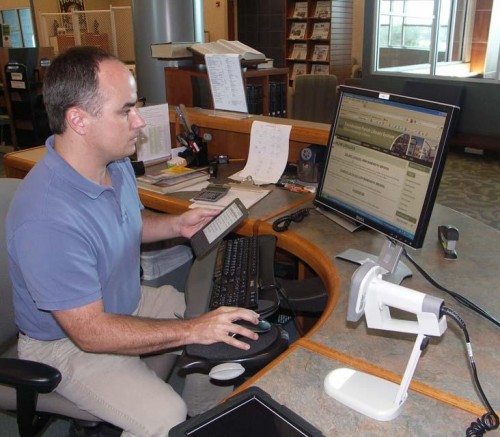Carl Lee Palmature Sr.
October 5, 2011Louisiana’s Power Rankings System a Joke
October 7, 2011Remember Dewey Decimals? Well, fuhgeddaboudit. Getting a good book from the public library is a different world than what it once was, and with the use of e-books and e-readers libraries have become entirely new centers for public service.
The Terrebonne Parish Public Library was among the first in Louisiana to implement technology with computerized cataloging and resources in addition to containing rows of bound books with hard covers that are printed on real paper.
Adding to their electronic tools, library officials announced this week that they now have the capability to download e-books on the popular Kindle device. As a result, casual readers and serious researchers have unlimited access to available volumes of material.
Additionally, those persons with a library card do not necessarily need to make a trip to the center of collected materials to pick up a good book. Depending on one’s equipment, volumes of material can be downloaded from home or work.
“For a long time the Kindle didn’t play nicely with our overdrive system for e-books,” TPPL reference librarian Ross Mays said.
Kindle is the proprietary mobile reader device for Amazon and also the first e-reader under that brand name. “That is why we are excited,” Mays said. “A lot of people have these and this is what first got people stated reading on e-readers.”
The library had other electronic readers available beginning in 2006, but many devices are limited in their capability and unable to download library books. In turn, they limited what could be offered to or used by the public.
An e-book, for those still learning or attempting to keep up with rapidly changing technology, are electronic files that can be downloaded on computer and communication equipment.
TPPL is working to transition what is called ePub for the use of their material. As a result, library personnel can offer patrons not only thousands of book titles, but 8,225 on-demand videos, which can be streamed from any computer, iPad or iPhone.
Patrons registered with the library can set up user accounts when they log in, and save favorites on their own e-readers.
The e-book system allows users to set preferences including high or low resolution and even text enlargement, which is often helpful to the visually impaired.
TPPL is also offering a one-year subscription to this service, during which time library personnel will evaluate their system.
The idea of e-books dates back to 1963 when filmmaker Ted Nelson first coined the concept and term hypertext. This is basically what set the stage for words to be typed on a screen and eventually emerged into the usage of images such as television crawls and computer monitor texts.
As technology progressed so did the advance of hypertext as Apple’s TidBITS became the first electronic magazine in 1990.
In 1998, talk of e-books began to emerge and by the turn of the century, and with the launching of the Sony reader in 2006, rapid strides were made to offer digital publishing in increased amounts and a variety of selections.
“We’ve had a small but dedicated following [of e-book users] since the early days,” TPPL reference supervisor Jennifer Hamilton said, “but it has been exploding in the last year. Since December [2010] when e-book readers became affordable [and] from December [2010] until now we have checked out at least 10 times more e-books than we did in the entire previous calendar year. With the introduction of library books for Kindle we expect those check-out numbers to skyrocket.”
By having an e-book downloaded on an individual’s e-reader, the amount of time, generally two weeks, that the book is on loan from the library does not require a trip to make it back to a return box on time. The e-book simply deletes itself on the designated date.
“The thing with e-books, as many people that want it can download it,” Mays said regarding inventory and public demand.
“We suspect that e-readers may get cheaper enough in the future that libraries may check them out,” We are not there yet. The price of an e-reader [generally $100] is higher than the price of a [hard copy] book we would lend,” Hamilton added. “So at this point it is unlikely we would check out e-readers. But when the e-reader devices become $25 or $30 we will be looking very seriously at checking them out.”
According to digital publishing solutions provider Aptara, one out of five e-book publishers generate more than 10 percent of their revenue from e-books, trade publishers claim that has increased from 50 percent to 75 percent during the past two years, more than 53 percent of e-reader owners have said they read more books now than ever before, and e-book sales increased by 176 percent in 2009 from the previous year.
Hamilton said that the only drawback regarding e-book usage at the time is that it is uncharted territory as the rapidly changing technology makes it difficult to keep ahead of what is usable. “We struggle with keeping up with the latest technology,” she said.
Mays related how he offered a class on e-books and each of his students had a different device, many of which were not compatible with one another.
“Classes don’t work well like that,” she said.
As a result, library personnel are modifying their approach to more one-on-one service when it comes to helping patrons use materials with their given e-readers.
Hamilton said the advantage of the e-book and e-reader is that it’s portability allows users the ability to download and carry material with them on the road, in an aircraft, at home or at work either on land or offshore.
At one time, library professionals worried about their futures with the emergence of electronic communication technology. That concern no longer exists.
“It just means that it is an even more exciting time for us,” Hamilton said. “It offers us more and more ways to improve the quality of service for our patrons. A good example is the patron who is traveling all the time for business and may be offshore or around the state then back home, and may not have checked out books in the past because they did not know when they would be back to return them.
“Now, with their Terrebonne Parish Library card, no matter where they are around the country or in the world, they can use their library card to check out a book.”
Hamilton said that the future of libraries includes them being viewed more and educational and public meeting centers.
“We are people who love to share information,” she said. “We want it to be easy for people to access it. We want parents who hear from their child the night before the report is due [to know that] from their home computer they can access all of these digital shelves of books, magazines, newspapers, sets of encyclopedias, everything they would need to have their child do a high quality report without leaving the home.”
Hamilton said that the public should know that while the library will always be present, the way people use it would be changing in time. “We are just as much a community center as we are an information center,” she said.
Hamilton and Mays said that they are prepared to help the public get connected with e-books regardless of the equipment individual patrons might have available.
In terms of who is using e-books, Mays said it is not what he and others expected. “Surprisingly, a lot of our patrons who have come in with e-readers are retirement age,” he said. “Sometimes it is because [e-readers] are capable of having larger text. A lot of times they have gotten them for Christmas and they are coming in asking for help.”
When it comes to technology and library usage, Mays said that the public does not always understand that the same printed material is available online.
“The difference is one is electronic and one is print,” he said. “The question is how does a kid cite that [reference] on a school paper? We are having to educate people on, ‘this is a good source although it is online.’ People don’t understand how much we have in print and online.”
Library patron Ben Meyers admitted he had never used an e-book or seen an e-reader before trying Mays’ Kindle. “It is interesting,” Meyers said. “It sounds pretty good. Definitely a time saver and easily accessible.”
Hamilton said that having an electronic connection helps the public make use of the library when they might not have time to go to the brick and mortar structure.
“People are [the ultimate] source of information,” Hamilton said. “People come together the share information and we want them to be able to do that at the library. You will see more online activity, and in the building itself you will see more programs and more community meetings and activities.
There is already more activity in the Terrebonne Parish Library System than there are a lot of libraries in much larger communities,” Hamilton added. “It is exciting to see.”
Reference librarian Ross Mays demonstrates how easily e-books are downloaded from the Terrebonne Parish Public Library. The new technology is changing how libraries operate and expanding what they can offer their patrons. MIKE NIXON












